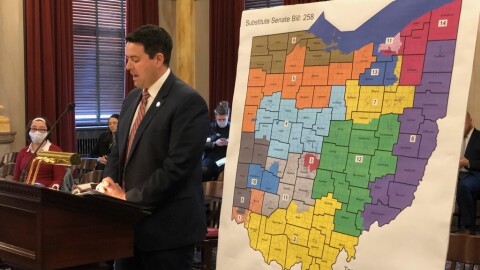It was back to work for the seven member commission that spent much of last year drawing new district maps for state lawmakers and Ohio’s Congressional delegation. The Ohio Redistricting Commission has just a few days to produce new Ohio House and Senate maps, after the Ohio Supreme Court ruled the maps the commission approved in September were unconstitutionally gerrymandered toward Republicans.
There wasn’t much on the first meeting agenda beyond the swearing-in of the only new member, House Minority Leader-elect Allison Russo.
Several members shared their impressions of what the Supreme Court’s ruling means to this new process. The previous maps had more than 64% of state legislative seats favoring Republicans, which the Ohio Supreme Court ruled violated the constitutional amendment voters approved in 2015 to take partisanship out of redistricting.
Governor DeWine, who said when he and other Republicans voted to approve those maps that he was “very very sorry that we are where we are." There are specific requirements the court laid out for the new maps: for instance, a 54% Republican, 46% Democratic split. DeWine said discussions have already started – though they’re not official public meetings.
“Obviously, members should be mindful that no more than three members may be present at any one time when discussing commission matters," DeWine said. "It's my understanding, Mr. Chairman, that these discussions have actually been going on that those who are actually looking at the maps and have that data in front of them have been talking among themselves."
Republican Secretary of State Frank LaRose said he cast his yes vote on the previous maps with “great unease” and was quoted in the court case as texting his chief of staff: “This rationale is asinine. I should vote no”.
He told the commission he’s very concerned about coming up with maps in time for the May primary.
“As this process continues, we are starting to become perilously close to reaching that point where that may become logistically impossible," LaRose said. "Let me be clear, the General Assembly has ordered me to conduct an election on May 3. And I am committed to making sure that that happens, but without finality on maps that starts to become mechanically impossible very soon. And so we need to reach that finality as quickly as possible.”
Russo agreed with the other Democrat on the panel, co-chair Sen. Vernon Sykes, that the court ruling spells out a 54%-46% split, and that the commission must do that unless they can’t do it.
Russo said it has already been done, in the six weeks before the previous maps were approved.
“We know from the prior work of this commission that there are many maps that have been proposed that meet all of those requirements," Russo said. "And so let's not move forward assuming that attempt is unachievable because it has been proven in prior attempts to actually do this.”
Republicans dispute that any map submitted in the previous map-drawing process meets all the constitutional criteria, not just the 54%-46% split.
After the meeting, Sykes and his Republican co-chair Speaker Bob Cupp took questions, with Cupp noting that the new maps are not due on Monday as is typical with government deadlines falling on weekends, but on Saturday.
"We are attempting to comply with the court decision and this has to be, although there's been work done over the weekend, this is the beginning of the process," Cupp said.
Sykes added, "I think we should be clear, I think we should be clear that we're not starting from scratch. This is a second round of map drawing and we have dozens of examples dozens of maps that comply with the percentage breakdowns. And so we have examples to help us and direct us and guide us to make the deadline."
Again, Republicans dispute that constitutional maps were submitted by the public or anyone else.
While public comment will be accepted this time too - via a website that Cupp said will be reactivated - Cupp says it’s still under discussion whether there will be public testimony.
Ten-year maps would require both Democrats to vote for them – which would almost certainly mean a unanimous vote, and quite a change from the process that yielded the previous maps.
The Commission also needs to redraw the Congressional map it created that was approved by state lawmakers and signed by DeWine on a party line vote in November. That map had to reduce the delegation from 16 to 15 members, and tipped 12 of those seats toward Republicans. It was ruled unconstitutional a few days after the legislative maps were.
Copyright 2022 The Statehouse News Bureau. To see more, visit The Statehouse News Bureau.



